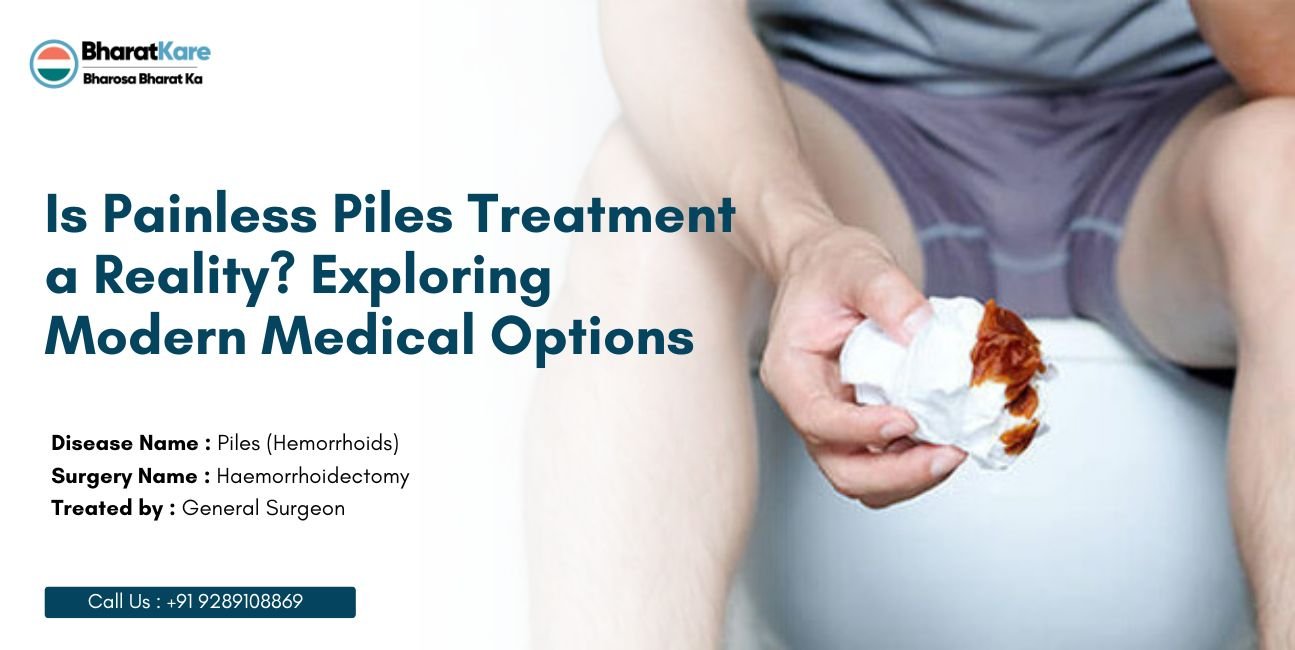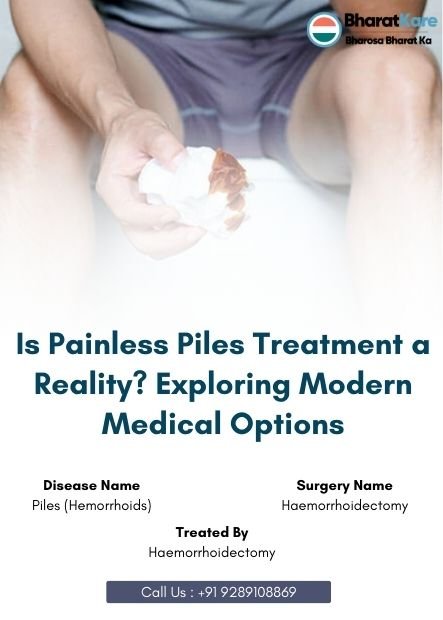Is Painless Piles Treatment a Reality? Exploring Modern Medical Options
Last Tuesday, I’m sitting in my usual coffee shop when this lady at the next table starts crying. Not sobbing – just quiet tears while staring at her phone. Being nosy (okay, concerned), I asked if she was alright.
Turns out she’d been googling hemorrhoid surgery videos. Bad idea. Really bad idea.
“I can’t take the pain anymore,” she whispered, “but those videos… I’d rather live with this forever.”
That conversation stuck with me. Because here’s what I know after two decades of writing about medical stuff – those scary videos she found? They’re from the stone age of hemorrhoid treatment. What we can do now? It’s a completely different ballgame.
So let me tell you about Painless Piles Treatment – not the marketing version, but what actually happens when you walk into a modern clinic in 2025.


The Truth About Modern Hemorrhoid Treatment
What My Patients Actually Tell Me
I’ve been collecting these stories for years now. Want to know the most common thing patients say after Painless Piles Treatment?
“Seriously? That’s it?”
Last month, this guy named Arun came to see Dr. Kapoor (I was shadowing that day). Arun had been putting off treatment for two years. TWO YEARS. Why? Because his brother-in-law told him horror stories from his 2015 surgery.
Arun’s laser treatment took eighteen minutes. He spent more time in the parking lot afterward, calling his wife to say he was done, than he did getting treated.
“But when will the real pain start?” he kept asking.
It never did.
Why Your Doctor Might Be Stuck in 2010
Here’s something that’ll blow your mind. I was at a medical conference last year where a surgeon admitted he’d never heard of some of the newest Painless Piles Treatment options. Not because he’s a bad doctor – he just specializes in heart surgery and hadn’t kept up with proctology advances.
Your family doctor probably learned about hemorrhoid treatment in medical school fifteen years ago. The techniques they studied? Ancient history now.
This is why finding the right specialist matters. You wouldn’t ask your dentist to fix your car engine, right?
The Treatments That Changed Everything
Laser Treatment – It’s Nothing Like You Think
The first time I watched a laser Piles Treatment, I was expecting some sci-fi drama. Beeping machines, dramatic lighting, maybe some sparks.
Nope. It’s about as exciting as watching paint dry. Which is exactly what you want when it’s your butt on the line.
Here’s what actually happens:
- You lie on your side (fully covered, completely dignified)
- They numb the area (feels like a tiny pinch)
- The laser does its thing (you might feel warmth, maybe nothing)
- Twenty minutes later, you’re putting your clothes back on
Seema, a teacher from Mumbai, described it perfectly: “I was more uncomfortable getting my yearly mammogram. At least with the hemorrhoid treatment, I could chat with the nurse the whole time.”
The laser shrinks the hemorrhoid tissue. No cutting. No removing chunks of your anatomy. Just gentle shrinkage over a few weeks.
Rubber Bands – Your Grandpa’s Method, But Way Better
When Dr. Joshi first mentioned rubber band ligation to Ramesh, his response was priceless: “What am I, a farm animal?”
Fair reaction. But modern rubber band treatment bears zero resemblance to whatever medieval torture your imagination conjures up.
These bands are thinner than dental floss. The placement tool looks like a fancy pen. The whole thing takes maybe ninety seconds per hemorrhoid.
Ramesh’s exact words afterward: “That’s what I was terrified of? My monthly dental cleaning is more uncomfortable.”
The Heat Treatment Nobody Talks About
Infrared coagulation sounds scary, but it’s actually the gentlest option. A tiny burst of infrared light – literally two seconds – and you’re done.
I watched Mrs. Patel get this treatment while we discussed her grandson’s wedding plans. She didn’t even pause the conversation when the doctor applied the infrared light.
“Oh, was that it?” she asked afterward. “I thought you were still getting ready.”
Don’t ignore the discomfort—consult a Painless Piles Treatment. Book your appointment today!
When Things Are More Complicated
Real Surgery That Doesn’t Suck
Sometimes lasers and bands aren’t enough. Maybe you’ve waited too long (like my stubborn neighbor who ignored symptoms for three years), or your hemorrhoids are just particularly problematic.
Enter THD – Transanal Hemorrhoidal Dearterialization. Sounds terrifying, right?
Here’s the reality: Vikram needed THD last fall. He’d prepared for weeks of misery. Bought special cushions, arranged to work from home for a month, warned his family he’d be grumpy.
Day three after surgery, he texted me: “Feel like an idiot. Back at office. Cushions unused. Wife laughing at my drama queen preparation.”
THD doesn’t remove tissue. It just ties off blood vessels. The hemorrhoids shrink naturally. No wounds, no stitches to pull out, no sitting on inflatable donuts.
The Stapling Method
For really complex cases, there’s stapled hemorrhoidopexy. Before you panic at the word “stapling,” remember – this is medical stapling, not the office supply kind.
It repositions tissue instead of cutting it out. Less trauma, faster healing, way more comfortable.
I met this businessman, Ajay, who needed stapled surgery. His biggest complaint afterward? “I took two weeks off work and only needed three days. Now I don’t know what to do with the extra vacation time.”
The Technology That Makes This Possible
Your Phone Is Now Part of Your Treatment
This is my favorite new development. The best hemorrhoid clinics now give you an app to track your recovery. Not because apps are trendy, but because they actually work.
Take Priya’s experience. Day three after her laser treatment, she noticed some minor swelling and panicked. Instead of rushing to emergency care, she took a photo through the app and messaged her care team.
Response within two hours: “Completely normal. Swelling should reduce by tomorrow. Ice packs are uncomfortable.”
She felt like she had a medical team in her pocket. Which, basically, she did.
Diagnosis That Doesn’t Make You Want to Die
Remember those awful examination stories your aunt shared? Forget them. Modern diagnostic equipment is designed for comfort and accuracy.
The high-resolution anoscope sounds intimidating but it’s basically a tiny camera. Most patients describe the exam as “awkward for thirty seconds, then over.”
Dr. Sharma showed me the difference between old-school examinations and modern techniques. Night and day doesn’t begin to cover it.
The Stories That Convinced Me
The Mom Who Couldn’t Wait
Kavita had twin toddlers and hemorrhoids that were making her life hell. But taking weeks off for recovery? Not happening.
Her infrared treatment was scheduled during her lunch break. She was back at daycare pickup that afternoon. The twins never knew anything happened.
“Best kept secret ever,” she told me six months later. “I’m pain-free, and nobody had to cover for me at work or home.”
The Golf Addict
Mr. Bhatt is sixty-three and obsessed with his Saturday golf game. His hemorrhoids were so bad he’d stopped playing – something his wife thought was impossible.
He got THD on a Wednesday. Played nine holes the following Sunday.
His golf buddies spent more time complaining about their knees than he did about his surgery recovery.
The Software Engineer’s Logic
Deepak is the most analytical person I’ve ever met. He researched Painless Piles Treatment options for eight months before booking a consultation. Created spreadsheets comparing success rates, read every medical paper published in the last five years.
His conclusion after laser treatment: “I spent more time researching this than the procedure took to perform and heal. Classic overthinking on my part.”
Choosing the Right Doctor
Red Flags I’ve Learned to Spot
After visiting maybe fifty hemorrhoid clinics, I can spot the good ones immediately. Here’s what makes me nervous:
- Doctors who spend more time talking about costs than treatment options
- Clinics that feel like factories (rushing patients in and out)
- Anyone who can’t explain the procedure in simple terms
- Places that make you feel embarrassed about your condition
What the Best Places Look Like
The good clinics feel more like comfortable medical spas than hospitals. Clean, modern, designed for privacy and comfort.
The staff acts like hemorrhoid treatment is the most normal thing in the world (which, for them, it is). No hushed voices, no embarrassed glances. Just professional, matter-of-fact healthcare.
Dr. Verma’s clinic has a coffee machine in the waiting room and magazines that aren’t from 2019. Small details that show they care about patient comfort.
Questions That Cut Through the Sales Pitch
When I’m evaluating a hemorrhoid specialist, I always ask:
“How many of these procedures did you do last month?” (You want someone who does this regularly)
“What happens if I’m still having problems in six months?” (Good doctors stand behind their work)
“Can you show me the actual equipment you’ll use?” (Modern tools should look current, not like museum pieces)
The Money Reality
Insurance Usually Covers This Stuff
Most Painless Piles Treatment options are covered by insurance when medically necessary. But insurance companies don’t advertise this – you have to ask.
Here’s the insider secret: insurers actually prefer covering these newer procedures. They’re cheaper than traditional surgery (no hospital stay, fewer complications) and more effective (lower recurrence rates).
What You’ll Actually Pay
If you’re paying out of pocket, here are realistic numbers from clinics I’ve researched:
- Laser treatment: ₹28,000-42,000
- Rubber band ligation: ₹10,000-18,000
- Infrared coagulation: ₹16,000-28,000
- THD surgery: ₹38,000-58,000
Yeah, it’s real money. But consider what chronic hemorrhoids cost in lost work days, pain medication, and quality of life. Most patients tell me it’s the best healthcare investment they’ve ever made.
Don’t ignore the discomfort—consult a Painless Piles Treatment. Book your appointment today!
Recovery Reality Check
The First Day Is Usually Boring
Here’s what typically happens after Painless Piles Treatment:
Morning: Procedure done, you’re in recovery drinking juice and feeling surprisingly normal Afternoon: Home, probably napping because anesthesia makes you sleepy Evening: Normal dinner, maybe some mild discomfort (think “sat too long in a bad chair”) Night: Sleep normally
That’s it. No crisis, no emergency calls to the doctor, no regrets.
Week One: When It Hits You
Around day four, most patients have the same realization: “Wait, I think I’m actually better.”
This is when people start calling their friends to share the news. The relief isn’t just physical – it’s emotional. You’re not constantly worried about bathroom emergencies or painful flare-ups.
Six Months Later: The Follow-Up
I try to check in with patients six months after treatment. The responses are remarkably consistent:
“I can sit through long meetings without shifting around constantly.” “Travel isn’t stressful anymore – no more scouting for bathrooms.” “My relationship improved because I’m not cranky and uncomfortable all the time.”
One guy told me his Painless Piles Treatment improved his marriage. His wife confirmed this.
Making the Decision
Why “Later” Never Comes
I’ve noticed people research hemorrhoid treatment for months before actually calling for a consultation. They’re waiting for the “right time” or for symptoms to get “bad enough.”
Here’s what I’ve learned: there’s never a perfect time, and symptoms rarely get better on their own. They just gradually get worse until you’re dealing with a much bigger problem.
The best time to address hemorrhoids is when they’re bothering you but still manageable. Don’t wait until you’re desperate.
Your First Visit Won’t Be Weird
First consultations are way less awkward than you expect. I’ve sat in on dozens (with patient permission), and here’s the typical experience:
10 minutes: Paperwork and medical history 15 minutes: Physical exam (much less invasive than you fear)
15 minutes: Discussion of options and scheduling
Most patients leave saying, “That’s what I was nervous about? I’ve had dental visits that were more uncomfortable.”
What’s Coming Next
The Future Looks Even Better
I recently toured a research facility working on next-generation hemorrhoid treatments. Some of the stuff they’re developing sounds like science fiction:
- Procedures that take under five minutes start to finish
- Treatments that require zero anesthesia
- Techniques that make recurrence almost impossible
But honestly? You don’t need to wait for the future. The Painless Piles Treatment options available right now are already amazing.
Time to Make the Call
Why This Matters to Me
That woman crying in the coffee shop? She called a modern hemorrhoid clinic the next week. Had laser treatment ten days later. Sent me a thank-you text three weeks after that.
“I wasted two years being miserable over something that took twenty minutes to fix.”
That’s why I write about this stuff. Too many people suffer unnecessarily because they don’t know better options exist.
Your Story Starts With One Phone Call
Here’s what happens when you finally call a Painless Piles Treatment center:
- You’ll talk to someone who’s heard your exact concerns hundreds of times
- They’ll explain your options without medical jargon
- You’ll schedule a consultation that fits your schedule
- You’ll discover the treatment isn’t nearly as scary as you imagined
- You’ll wonder why you waited so long
What You Actually Deserve
After twenty years writing about healthcare, I believe everyone deserves to live without chronic discomfort. Painless Piles Treatment isn’t some luxury procedure – it’s basic healthcare done right.
You deserve doctors who explain things clearly, procedures that respect your time and comfort, and results that actually last.
The Bottom Line
Is Painless Piles Treatment real? Ask the hundreds of patients I’ve talked to who wish they’d known about these options sooner.
The treatment you’ve been dreading is probably comfortable, quick, and life-changing. The hardest part is making the decision to seek help.
Modern hemorrhoid specialists across India are making these treatments more accessible every month. The suffering you’ve been enduring doesn’t have to continue.
Painless Piles Treatment isn’t just possible anymore – it’s the standard. The question isn’t whether it works, but whether you’re ready to feel better.
Tags :- Painless Piles Laser Surgery Clinic Near Me in Vadodara, Piles Surgery Recovery Time, Laser Surgery for Piles: Cost, Benefits, and Recovery Time, Comparison between Piles and Anal Fistula, Laser Piles Surgery Options in Patna, Step-by-Step Guide to Recovery After Piles Operation, Low Cost Piles Laser Surgery in Vadodara, Affordable Piles Treatment Near Me, Best Piles Specialist in Ahmedabad Near Me, Affordable Piles Treatment Laser Surgery, Top 5 Reasons Your Piles Aren’t Healing” , Piles Home Remedies not working
FAQ
FAQs About Painless Piles Treatment: Answering Your Most Common Queries
Yes, they are completely different. Those graphic videos typically show traditional excision surgery, which is now considered an outdated approach for most cases. Modern "painless" treatments like laser, infrared coagulation, and THD are minimally invasive. They work by shrinking or repositioning tissue without major cutting, which is why they involve minimal pain, no hospital stay, and a very quick recovery—often within a day or two.
The article emphasizes that for most patients, the recovery is surprisingly boring. The common fear of "when will the real pain start?" is often unfounded. The first day typically involves mild discomfort, comparable to sitting too long on a hard chair, not sharp pain. By day three or four, most people realize they are already feeling significantly better. The technology is designed to minimize tissue trauma, which directly translates to a much easier healing process.
The article suggests asking specific questions to gauge a doctor's expertise:
- "How many of these procedures did you do last month?" (You want a specialist who performs them regularly).
- "Can you show me the actual equipment you'll use?" (Modern tools like lasers and high-resolution scopes look advanced, not old-fashioned).
- "What happens if I'm still having problems in six months?" (A good doctor will stand behind their work).
A red flag is a clinic that rushes you, can't explain the procedure simply, or makes you feel embarrassed about your condition.
"Painless" refers to the patient experience being vastly more comfortable than the pain of traditional surgery or the chronic pain of the condition itself. During the procedure, the area is numbed with local anesthesia, which feels like a tiny pinch. Patients often report feeling only warmth or nothing at all, and are able to have a conversation with the nurse throughout. The term signifies the drastic reduction in both procedural and recovery pain.
This is a key point from the article. Most general practitioners learned about hemorrhoid treatment in medical school years ago and may not be up-to-date on the latest advances in a specialized field like proctology. They are experts in general health, not necessarily in the newest minimally invasive techniques. It's crucial to consult a specialist who focuses specifically on modern hemorrhoid treatment for the most current and appropriate options.
Quick Links
Popular Surgeries
Find Us
© Copyright BharatKare 2025. All Right Reserved.


